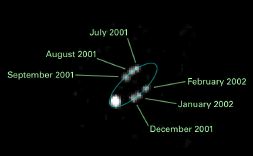

,
|
Документ взят из кэша поисковой машины. Адрес
оригинального документа
: http://www.stsci.edu/~inr/thisweek1/2008/thisweek252.html
Дата изменения: Wed Oct 21 22:32:10 2009 Дата индексирования: Tue Nov 24 06:24:06 2009 Кодировка: Поисковые слова: п п п п п р п c 1999 s4 linear |


,
| Program Number | Principal Investigator | Program Title | Links |
| 10884 | Gray Wegner, Dartmouth College | The Dynamical Structure of Ellipticals in the Coma and Abell 262 Clusters | Abstract |
| 11103 | Harald Ebeling, University of Hawaii | A Snapshot Survey of The Most Massive Clusters of Galaxies | Abstract |
| 11113 | Keith S. Noll, Space Telescope Science Institute | Binaries in the Kuiper Belt: Probes of Solar System Formation and Evolution | Abstract |
| 11130 | Luis Ho, Carnegie Institution of Washington | AGNs with Intermediate-mass Black Holes: Testing the Black Hole-Bulge Paradigm, Part II | Abstract |
| 11144 | Richard Bouwens, University of California, Santa Cruz | Building on the Significant NICMOS Investment in GOODS: A Bright, Wide-Area Search for z>=7 Galaxies | Abstract |
| 11151 | Gregory J. Herczeg, California Institute of Technology | Evaluating the Role of Photoevaporation of Protoplanetary Disk Dispersal | Abstract |
| 11156 | Kathy Rages, SETI Institute | Monitoring Active Atmospheres on Uranus and Neptune | Abstract |
| 11158 | R. Michael Rich, University of California - Los Angeles | HST Imaging of UV emission in Quiescent Early-type Galaxies | Abstract |
| 11175 | Sandra M. Faber, University of California - Santa Cruz | UV Imaging to Determine the Location of Residual Star Formation in Galaxies Recently Arrived on the Red Sequence | Abstract |
| 11178 | William M. Grundy, Lowell Observatory | Probing Solar System History with Orbits, Masses, and Colors of Transneptunian Binaries | Abstract |
| 11196 | Aaron S. Evans, State University of New York at Stony Brook | An Ultraviolet Survey of Luminous Infrared Galaxies in the Local Universe | Abstract |
| 11212 | Douglas R. Gies, Georgia State University Research Foundation | Filling the Period Gap for Massive Binaries | Abstract |
| 11218 | Howard E. Bond, Space Telescope Science Institute | Snapshot Survey for Planetary Nebulae in Globular Clusters of the Local Group | Abstract |
| 11235 | Jason A. Surace, California Institute of Technology | HST NICMOS Survey of the Nuclear Regions of Luminous Infrared Galaxies in the Local Universe | Abstract |
| 11291 | Kris Davidson, University of Minnesota - Twin Cities | Following Eta Carinae's Change of State | Abstract |
| 11544 | Adam L. Kraus, California Institute of Technology | The Dynamical Legacy of Star Formation | Abstract | q
| 11548 | S. Thomas Megeath, University of Toledo | NICMOS Imaging of Protostars in the Orion A Cloud: The Role of Environment in Star Formation | Abstract |
GO 11113: Binaries in the Kuiper Belt: Probes of Solar System Formation and Evolution
 A composite of HST images of the Kuiper Belt binary, WW31
A composite of HST images of the Kuiper Belt binary, WW31
|
The Kuiper Belt consists of icy planetoids that orbit the Sun within a broad band stretching from Neptune's orbit (~30 AU) to distance sof ~50 AU from the Sun (see David Jewitt's Kuiper Belt page for details). Over 500 KBOs are currently known out of a population of perhaps 70,000 objects with diameters exceeding 100 km. Approximately 2% of the known KBOs are binary (including Pluto, one of the largest known KBOs, regardless of whether one considers it a planet or not). This is a surprisingly high fraction, given the difficulties involved in forming such systems and the relative ease with which they can be disrupted. It remains unclear whether these systems formed from single KBOs (through collisions or 3-body interactions) as the Kuiper Belt and the Solar System have evolved, or whether they represent the final tail of an initial (much larger) population of primordial binaries. This proposal will use WFPC2 imaging of known KBOs to identify new binary systems. |
GO 11144: Building on the Significant NICMOS Investment in GOODS: A Bright, Wide-Area Search for z>=7 Galaxies
GO 11175: UV Imaging to Determine the Location of Residual Star Formation in Galaxies Recently Arrived on the Red Sequence
Galaxy mergers and the red sequence
The overwhelming majority of galaxies are found in clusters. Observations show
that almost all well-defined cluster systems at low and moderate redshift have a
significant population of elliptical galaxies
which have red colours, indicative of old stellar populations and minimal current star formation.
The elliptical galaxies outline a distinct sequence in the colour-magnitude (or colour-mass) diagram, the
so-called
GO 11544: The Dynamical Legacy of Star Formation